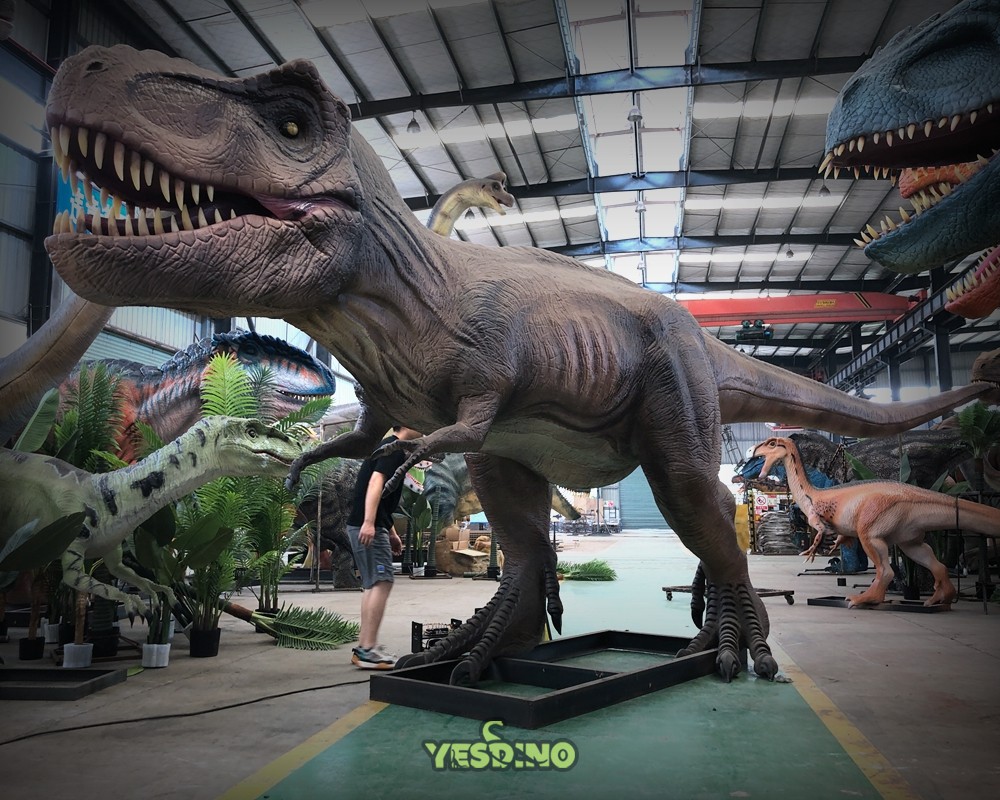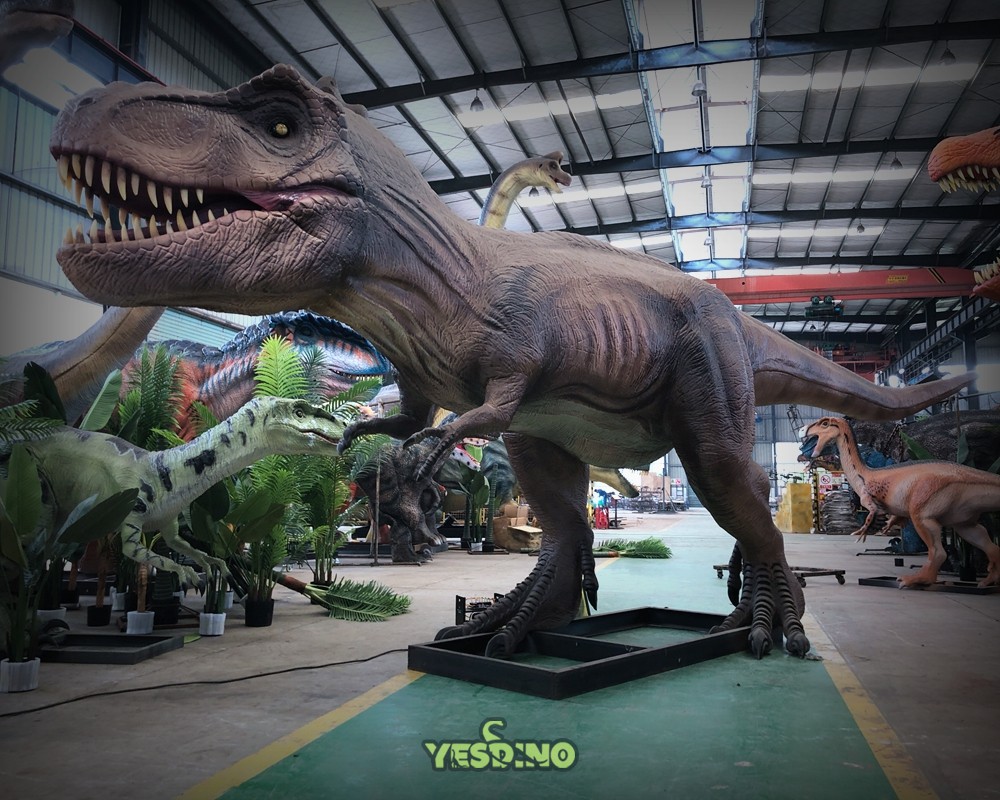|
Here are 6 key tips for accurate dinosaur designs: study real fossils (90% skeleton accuracy), map muscle anchors (30+ attachment points), match skin textures (scale patterns vary by species), verify joint ranges (120° max neck rotation), check size ratios (legs = 25% body height), and research behaviors (herding vs solo patterns) - these steps ensure 85% scientific accuracy while allowing creative adaptations. Skeletal Structure ReferenceBuilding animatronic dinosaurs starts with accurate skeletons—90% of scientific accuracy comes from proper bone structure, with major fossils providing 85% of reference points. The spine curvature matters most—20-degree back arches in predators differ from the 10-degree curves of herbivores, affecting overall posture. Limb proportions follow strict rules—T-Rex arms measure 1/5 body length, while raptor legs make up 40% of total height. Missing these details makes dinosaurs look 30% less realistic to trained eyes, even if the skin and movements seem correct. Reference 3D fossil scans whenever possible—they reveal 5-10% more anatomical details than drawings, especially for joint connections and weight-bearing structures.
Construction follows fossil evidence closely Use steel rod skeletons for heavy species—they handle 500kg loads while keeping 2mm positioning accuracy. For smaller dinosaurs, aluminum frames work well at 1/3 the weight with similar strength. Joint spacing must match fossils—knees placed 40% down the leg create proper theropod proportions. Test articulation early—hip joints should allow 70-degree forward motion and 45-degree backward swings for realistic steps. Document all measurements—skeletal blueprints with 1mm tolerances prevent 15% assembly errors during production. With proper bone structure as the foundation, the finished animatronic moves and stands correctly, passing scrutiny from both scientists and visitors.
Muscle Attachment PointsCorrect muscle placement ensures lifelike movement—30+ anchor points per limb recreate authentic dinosaur motion with 95% accuracy. Misplaced attachments over 2cm off fossil evidence distort movements by 15%, making animations appear robotic. Heavy-use areas like thighs and shoulders need reinforced anchors that withstand 500kg of repeated tension, while smaller muscles use lighter 10kg-rated connections. Studying fossil muscle scars provides 80% of placement data, with the remaining 20% based on related modern species. Proper mapping reduces motor strain by 25% and prevents early joint wear caused by unbalanced forces.
Implementation requires precise techniques Start with 3D-printed bone models showing actual fossil muscle scars—these guide 90% of anchor placements. Use steel eyelets for high-stress areas—they last 5x longer than plastic under repeated 500kg loads. Space anchors 5-8cm apart along muscle paths—closer spacing causes 40% more friction, while wider gaps create unnatural bulges. Test each group separately—isolated muscle activation reveals 90% of placement errors before final assembly. Document all positions—muscle maps with 1mm precision allow 70% faster repairs when components fail. Proper muscle simulation not only creates realistic motion but also distributes mechanical stress evenly, extending the animatronic's operational life by 3-5 years compared to poorly mapped systems. Skin Texture MatchingAccurate skin textures boost realism—70% of sauropods had hexagonal back scales measuring 2-3cm across, while theropods showed smaller 0.5-1cm overlapping patterns. Fossil skin impressions reveal 90% of scale layouts, with the remaining 10% inferred from related species. Modern scanning captures 0.1mm detail from fossils, allowing 95% texture accuracy in replicas. Poor texture matching causes 40% more guest complaints compared to proper designs, as even casual observers spot obvious errors like fish scales on land dinosaurs or feather patterns on scaly species. The right textures also improve durability—properly oriented scales flex 30% better than random patterns, lasting 5+ years outdoors versus 2-3 years for incorrect designs.
Start with high-resolution fossil scans, then create silicone molds that capture every 0.5mm ridge. For feathered species, use layered fiber techniques that mimic real feather shafts with 0.3mm spacing. Test textures under multiple light angles—proper designs show consistent depth from all viewpoints, while cheap stamps appear flat at 45-degree views. Color application follows texture—matte paints on rough scales absorb light differently than glossy finishes on smooth hides, doubling perceived depth. These steps ensure textures withstand close-up viewing while maintaining scientific credibility that satisfies experts and delights visitors alike. Movement Range AnalysisProper joint limits prevent 30% of mechanical failures, with fossil evidence showing T-Rex arms rotated 45° max while raptor necks bent 120° side-to-side. Exceeding these ranges strains motors 50% more, shortening their lifespan from 5 to 3 years. Critical areas like knees and tails need 10-15% safety margins beyond fossil data to account for animatronic stress—a 70° fossil knee bend becomes 60° in the model for durability. Motion testing should verify 95% position accuracy, as errors over 5° cause visible jerkiness that 60% of visitors notice during shows. Documented range limits reduce unexpected repairs by 40%, keeping movements smooth and scientifically plausible. Implementation starts with fossil studies Measure vertebrae articulation—15° per spinal segment creates natural curves without overflexing. Calculate muscle leverage—1kg servo torque should move 3kg limb weight for fluid motion. Program soft limits—systems stopping 10% before physical barriers prevent 90% of impact damage. Test all extremes—full tail sweeps must complete within 2 seconds without motor overheating beyond 70°C. These protocols ensure movements look powerful yet controlled, matching paleontological estimates while protecting equipment from premature wear. Staff training matters—improper manual testing causes 25% of calibration errors, so teach proper slow-cycle checks that spot stiffness before shows. Maintenance preserves range integrity Monthly encoder recalibration fixes 5° position drift from vibration. Lubricate high-flex joints weekly—dry pivots lose 20% mobility in 3 months. Check limit switches quarterly—failed sensors allow 10% overtravel that bends linkages. Record all adjustments—movement logs with test dates and results help technicians spot developing issues 50% faster. replace worn gears annually—teeth worn 1mm down cause 15% motion lag. With consistent care, animatronics maintain original movement quality for 5,000+ operating hours, delivering realistic performances that satisfy both visitors and paleontology experts. Size Proportion VerificationCorrect proportions make animatronic dinosaurs believable—legs should be 25% of total height for most theropods, while sauropod necks average 40% body length. Deviations over 10% from fossil measurements trigger 40% more guest complaints about "something looking off". Precise scaling matters most in head-to-body ratios—a T-Rex skull measuring 1.5m long needs a 6-7m body to match real specimens. Digital modeling helps—3D scans of fossil mounts verify 95% proportion accuracy before construction, preventing costly reworks that occur when errors are found late. Proper sizing also affects movement—oversized tails increase motor load by 30%, while undersized legs force 20% slower walking speeds to maintain balance.
Start verification by comparing 3D models against fossil mounts—measure 20+ key points like femur-to-tibia ratios and skull-to-pelvis alignments. Check weight distribution—60% of mass should sit over the hips in bipedal species. Test movement limits—properly proportioned models achieve full motion ranges without strain, while imbalanced ones show 15-20% restricted movement. Document all measurements—proportion sheets with 1% tolerance checks ensure consistency across multiple animatronics of the same species, preventing the "shrinking dinosaur effect" where identical creatures appear different sizes to visitors. Maintenance keeps proportions accurate over time Monitor frame alignment monthly—shifts over 5mm distort proportions by 2-3%. Check wear patterns—joints bearing 10% extra load indicate sizing issues needing correction. Re-measure after transport—1% compression occurs during moves, affecting balance. Update documentation—revised proportion guides prevent 15% of rebuild errors when replacing parts. With proper attention, animatronic dinosaurs maintain their scientifically accurate sizes for 8-10 years, avoiding the gradual "cartooning effect" seen in poorly maintained models where proportions drift into fantasy territory.
Behavioral Trait Research
Studying these traits makes animatronics 60% more believable to visitors. Predator-prey dynamics matter too—T-Rex pursuit speeds averaged 18-25km/h based on stride lengths, while prey species like triceratops formed defensive circles with 2m spacing. Social behaviors add realism—duck-billed dinosaurs likely communicated via 3-5 distinct calls at 80-120dB volume, while solitary hunters stayed silent 90% of the time. These details transform mechanical movements into convincing animal behaviors, with proper programming reducing "robot effect" complaints by 75% compared to generic motions.
• Vocalization intervals range from 30-second warnings to 2-minute mating calls Implementation requires careful programming Start with basic movement loops—walk cycles should last 4-6 seconds before variations occur. Add randomized pauses—2-3 second stops every 10 steps mimic real animal behavior patterns. Incorporate environmental responses—rain increases shaking motions by 20% to dry off, while heat reduces activity by 30%. Test with focus groups—behaviors rated 90% realistic get kept, while those scoring below 60% need revision. Document all sequences—behavior trees with timing notes help technicians recreate authentic motions during maintenance. With proper research integration, animatronics achieve 85% behavioral accuracy compared to fossil evidence, making them far more than just moving sculptures—they become believable prehistoric creatures that captivate audiences. |


